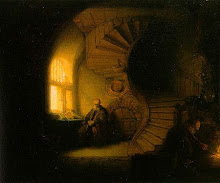Belvedere Castle is a Victorian folly built in 1869. Like many other of Central Park’s charms, we came upon it without knowing it was there.
In architecture, a folly is a building constructed fundamentally for adornment, to enhance a location with its charm and oddity. Originally, these buildings had no other use, but over time they often assumed a secondary purpose, which was the case with Belvedere Castle. In 1919, the National Weather Service began taking measurements from the castle’s tower with scientific instruments that determine wind speed and direction. Rainfall data was recorded just south of the castle and sent to the weather service’s forecast office at Brookhaven National Library on Long Island. The castle is still used for this purpose today.
I like stone. Stone structures particularly. I like to feel the stone with my hand, its roughness and density, and take in the weight and massiveness of it with my inner, proprioceptive barometer, mounting granite steps, leaning against the wall of a parapet or balcony, matching soft skin to hard stone.
Solidity is calming. It offers cloister from the chafing of the rough, chaotic world. It endures the vagaries of time. Fronts the blasts of foreign trumpets. Its roughness is a balm. Its density dazzles the blood.
The castle is mounted on Vista Rock and takes in a broad, panoramic view of the park. Roberta hadn’t been able to find film for her camera at the Duane Reade drugstores all over town. It would seem that the digitalized camera is now so popular no one bothers to stock film anymore.
A trim, well-dressed young man with black hair happened by when we were standing on the balcony and asked if we could take his picture. I held Roberta's purse while she photographed the man. Three young women happened by and stood behind him. "What luck,"I said, "you've got some pretty girls in the background." I have a facility for saying dumb things. One of the women glanced embarrassedly my way, though I think there was a hint of amusement on her face as well. Roberta got the picture, and I asked the young man where he was from. Columbia, he said.
We climbed a narrow spiral of granite steps to the very top of the castle and looked out, then returned to the balcony below. We passed through a room where a man sat a desk with maps and merchandise in a glass counter. "We'll take it," I said. He looked at me with confusion. "Take... wha.... " "The castle. We like it. When can we move in."
There is a serene body of water below the castle called Turtle Pond, which is man-made, and filled with New York drinking water. There are five species of turtle in the pond: Red-Eared Slider, Snapping Turtle, Eastern Box Turtle, Musk Turtle, and Black Skimmers. The pond is also full of little fish, pets people discarded when they moved and did not have the heart to flush down the toilet.
Below the castle, scattered on the ground below a deciduous tree with thick, blunt, lumpy branches were a litter of long black pods. Roberta picked one up and said it was a Kentucky coffee tree. Kentucky pioneers roasted the seeds as a substitute for coffee, a practice they relinquished with relish when the real thing became available.
Tuesday, November 9, 2010
Subscribe to:
Post Comments (Atom)


No comments:
Post a Comment